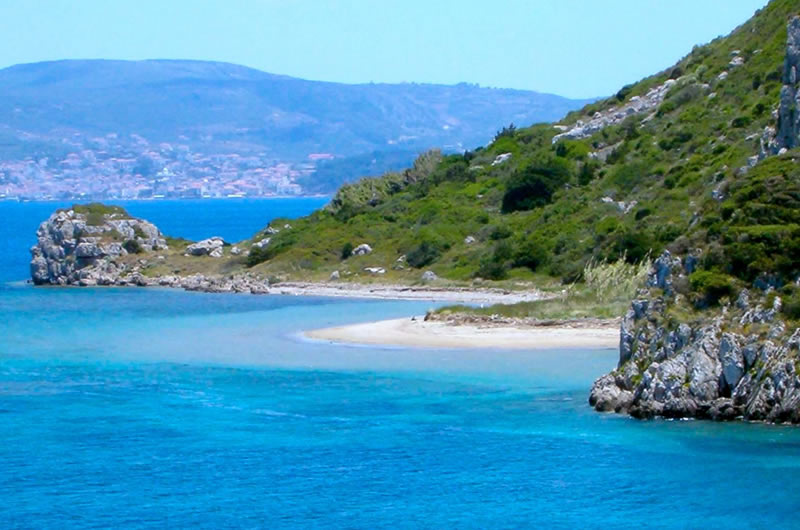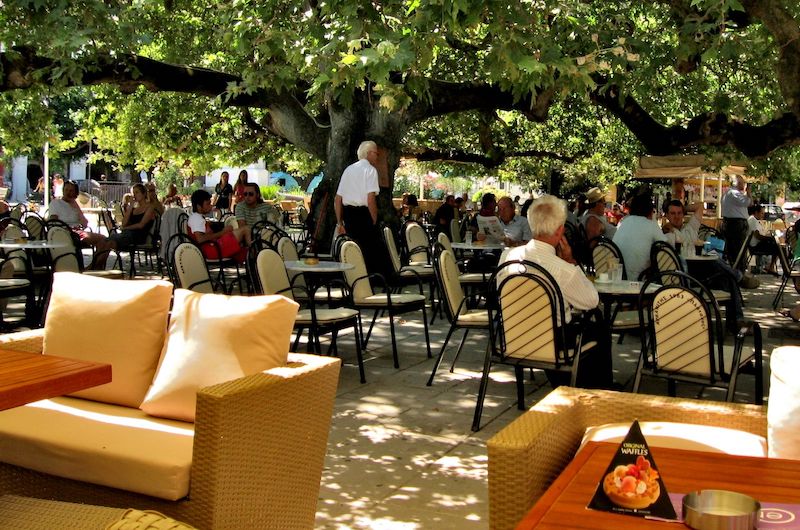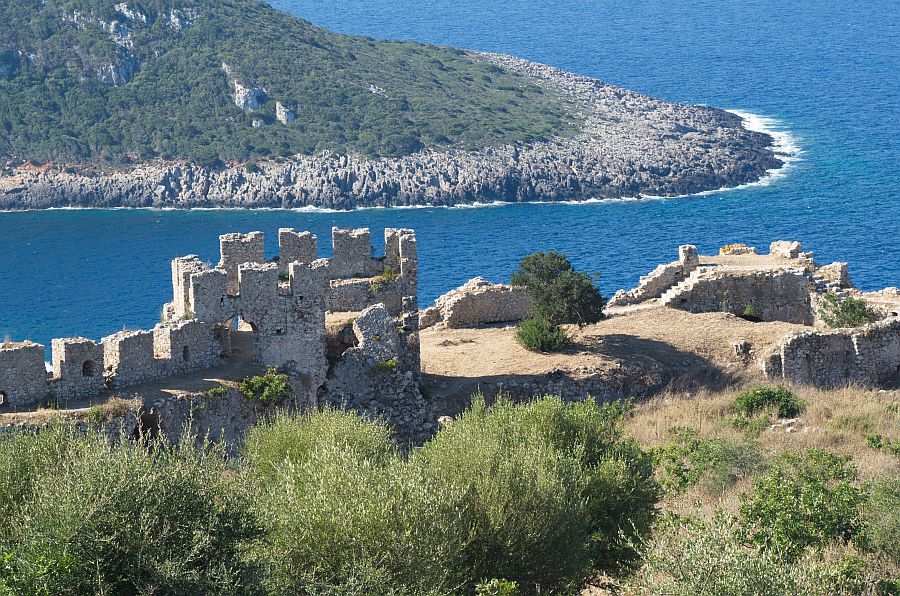10 Unmissable things
Not on every visitor’s radar, Pylos can prove to be one of Greece’s most fascinating places… when you give it a chance.
No matter what time of year you plan to visit, here is a list of the top 10 things to do in Pylos.
Castle of Pylos - Niokastron
Two castles are built on the summits of the two hills at the ends of the Bay of Navarino, overlooking the town of Pylos: the older castle of Navarino, called Palaiokastron or Palaionavarinon and the more recent castle, called Niokastron.
The latter was built in 1573 by the Turks, and in 1686 was given over to the Venetians. It again came under Turkish domination in 1715, along with the castle of Koroni and Palaionavarino. In 1816 it was captured by Ibrahim Pasha and remained under his control until 1828 when it was liberated by the French general Maison. During the Second World War it was used as the seat of the Italian and, later, the German headquarters.
Large-scale restoration work has been carried out for many years. The restored hexagonal Fortress on the top of the hill houses the Museum and the Underwater Archaeological Research Centre.
The most important monuments of the site are:
The Castle.It is divided into two main sections:
- Enceinte-Lower Castle; the larger of the two sections occupies the slope of the hill and is built of ashlar limestone blocks.
- Upper Castle; hexagonal fortress with massive battlements and projecting bastions which protect five of the six corners of the walls.
Church of the Metamorphosis (Transfiguration). Cross-in-square domed church dedicated to the Transfiguration of Christ. It was used as a Moslem mosque and was later converted into a Christian church.
General Maison's building. Rectangular, two-storeyed stone building erected in the 19th century. It has been reconstructed and now houses the Museum and the offices.
Tickets
Full: €6, Reduced: €3
Special ticket package: Full: €6, Reduced: €3
Valid for: Castle, Archaeological Museum Of Pylos, exhibition of the Ephorate of Underwater Antiquities in Pashas building, exhibition of the Ephorate of Underwater Antiquities in the Makrigiannis bastion, Church of Transfiguration of Christ.
Open
Winter:
From the 7th of January untill the 28th of February 2019
08:30 a.m. up to 15:30 p.m.
From 1-3-2019 to 20-5-2019
08:30 am to 16:00
Closed on Tuesday
Summer:
Extended 08:00-20:00
1st to 15th September: 08:00-19:30, 16th to 30th September: 08:00-19:00, 1st to 15th October: 08:00-18:30, 16th to 31st October: 08:00-18:00.

Sfaktiria Island
In front of Pylos and in the entire opening of the Bay of Navarino, the islet Sfaktiria extends, which acts as a natural breakwater and makes the port of Pylos one of the safest ports in the Mediterranean. Sfaktiria is a long and narrow island that covers an area of 3.5 square kilometers.
During the Peloponnesian War, Sfaktiria experienced a terrible and bloody battle between the Spartans and the Athenians, with their first being completely defeated. At Sfaktiria another battle was also held, during the Revolution of 1821, between the Greeks and their alliances and supporters on one hand, and the Turk-Egyptians on the other. The date of the battle was on April 16 1825 and it ended with the defeat of the Greek forces. On the south side of Sfaktiria, a monument in honor to the Greeks soldiers who lost their lives at this battle was built in 1959.
As we move northern, there is the tomb of Paul Bonaparte, the nephew of Napoleon, who was killed in 1827 due to the firing his gun on the navy frigate Hellas. The corpse was buried, finally, at Sfaktiria in 1832 after spending five years in a barrel of rum. Further north, at the coast, there is the monument of the philhellene Earl Santaroza, who was killed at the battle of Sfaktiria.
If you keep going northern, you will see that there is still is the monument dedicated to the Russians who died at the Battle of Navarino. Next to this monument there is the Russian church of St. Nicholas, which is a donation of the expatriates from the city Petrozavontse. This church is a wooden construction with no nails and cement.
In the northern part of Sfaktiria, there is the “Steno of Sikia”, a marine line of maximum width of 150 meters, which ceased to operate as an entry of the port the Turks sunk the destroyed ships from the naval battle of Nafpaktos in 1571. The islet of Tsichli Baba or Fanari is located to the south.
Today, Sfaktiria can be visited by boat and by swimming at the small beaches. The island is also suitable for diving. You can definitely admire and feel amazed by the beauty of the rocky location but the view over the bay of Navarino on one side and the Ionian Sea on the other will also impress you as well.

Pylos Lagoon (Divari)
The wetland between the settlement of Gialova and the bay of Voidokilia, which has been declared as an archaeological site, spreads over 6,000 acres of land and is known as Divari (from the Latin vivarium, which means “fish hatchery”); it’s depth does not exceed 4 m. This lagoon is the southernmost stop of the migratory birds of the Balkans travelling to and from Africa. The wetland offers refuge to 254 bird species, such as herons, cormorants, kestrels, Aegean seagulls, flamingos, ospreys, imperial eagles and other aquatic birds. The area also hosts the very rare, almost-extinct in Europe species of the African chameleon.
Apart from the ferrets, foxes and weasels that hunt its eggs, this serpent is mainly endangered from the overwhelming human presence, especially during the summer months, with the large tourist crowds. The Ornithological Society’s observation station gives the visitors the opportunity to learn and to observe this shallow, brackish-water lake, which has been included in the Natura 2000 network, and to roam around the paths that describe Pylos’s different ecosystems.
The larger birds, such as the herons, kestrels and Eurasian curlews, arrive at the lagoon in waves during the day and stay only for a few hours, in order to rest. Before dusk, they all fly away together. The smaller birds, such as the charadriiformes, usually arrive at night, stay in the wetland for many hours in order to feed, and most often fly away in the early evening.
The main threats are fishing, the increased saltiness in the fresh-water marshes –as a result of drawing water for agricultural use, both from the surface and from underground– and also hunting and the filling of the wetland with debris. The low agricultural intensification, coupled with intensive fishing, the drawing of underground water and the ever-increasing development in tourist facilities are the biggest threats to the wetland. The area has been nominated as a Special Conservation Area.

Voidokilia Beach
Voidokilia Beach, Bay, Curve is not only one of the most beautiful beaches in Greece, but maybe also in the Mediterranean Sea.
The sheltered bay is referred to in Homer's Odyssey and archaeologists believe it was used by King Nestor as a port in ancient times.
Situated at 12 km from the city of Pylos (in the north of the Navarino bay), you reach from the village of Petrochori.
The curve of Voidokilia seems to be traced with a compass like a giant Greek omega (the name means "cow's belly"), from the two rocky promontories that define the entrance of it. It is surrounded by a magnificent beach of light, fine sand, protected by the wind, and the crystalline beach invite somone to go swimming.
Voidokilia is hidden behind sand dunes, which seem to be protecting its secret of magic beauty. The beach of outstanding beauty lies beneath the Old Frankish castle (Paliokastro) and the cave of King Nestor, the ancient King of Pylos, who according to legend, used this cave as a haven for his cattle. Taking the path up from Voidokilia to the Old Navarino castle you will enjoy the wonderful panorama that unfolds in front of you: the Divari lagoon of Gialova, Navarino Bay and the Peloponnesian hills covered with olive trees.
Voidokilia Bay has been recognised officially as a landscape of exceptional natural beauty by the Greek government, and is one of the most captivating spots in Greece.
No other geological formation like it exists elsewhere. The area is considered of archaeological interest, so it has remained intact by civilization.
From Voidokilia beach you can pass onto the lagoon of Gialova through a natural path to observe the lagoon’s bird life, and the fascinating world of one of Europe’s most important wetlands.

Cave of Nestor
Above the beach of Voidokoilia, in Messinia, on the rock that Palaiocastro is also built, you will see a quite visible cave. This is the mythical Cave of Nestor, an Homeric herowho was the son of Neleus.
This is a spacious cavern with 20Ch16m dimensions and a height of up to 30 meters, with majestic walls and an almost triangular entrace. It has been identified with the legendary cave where the newborn god Hermes concealed the herd that he stole from the Sun-Apollo, but also with the cave where the flocks of Neleids and especially Nileas stayed a whole night. The cave was mentioned by Pausanias (D.36, 2).
Henry Schliemann brought to light some findings of the period of Nestor, who testify the existence of life since those early years. Inside the Cave of Nestor, stalactites are visible.
The access to the Cave of Nestor is relatively easy, as it is located right at the foot of the wall of Palaiocastro. You can go up the dune at the end of the beach Voidokoilia, then follow the uphill plateau and you will find yourself in front of the Cave of Nestor, from where the view is simply unique.

Castle of Pylos - Paleokastro
Paleokastro, on the northern side of the Navarino Bay, was built around the 13th century by Franks and is the oldest of the two castles located in the area. In 1573 it gave its way to Niokastro, which was built by the Ottomans near the entrance to the port of Pylos.
According to archaeological findings, the castle have been built above the ruins of an ancient acropolis of the Classical period. Next to the castle is the famous cave of Nestor, mentioned also by Pausanias: there, according to tradition, the young Hermes hid the 50 cows he had stolen from Apollo. According to another legend, this cave was used as a stable by Nileas and his son, Nestor.
The castle stands imposingly on a rock 200 m. above ground and is surrounded by steep cliffs. It is a rectangular structure that includes square and round towers. Despite the fact that access to it is not restricted, and that it is kept in relatively good condition, Paleokastro is closed today because roaming around its premises may be dangerous.
Palaiokastro as its name reveals, is the oldest castle in the Pylos region, built in the 13th century by crusader Nicholas II de Saint Omer, of French origin, also known as the Lord of Thebes, whom the Greeks called Santameris or geronikolas.
Palaiokastro held a leading role in all the battles that took place around Pylos, until it was abandoned for the newer castle (Niokastro) and took on a secondary role.
The castle followed the common fate of the Greek castles of the period; constantly changing owners, depending on the prevailing aspiring conqueror of the moment. In the 14th century the castle was occupied by the Genovese, who used it as a base for their war activities in Messinia against the Venetians. The latter, disturbed by the threat of the Genovese to their commercial interests, attempted to buy the castle several times. In 1423 they managed to buy it from the Prince of Achaea, Centurione II Zaccaria, during the second Venetian-Turkish war.
The castle however finally fell into the hands of the Ottomans. After their successive victories, the Ottomans built the new castle (Niokastro), which served them better geographically, leaving a rudimentary guard at Palaiokastro. After the sixth Venetian war, in 1686 the castle passed once again to the Venetians, while with the next Venetian war it fell back into Ottoman hands. After the Ottomans left the Greek territories in 1828, the castle was left to ruin.
The view offered by Palaiokastro to the Ionian Sea and the exceptionally beautiful Bay of Voidokoilia is truly enchanting. Access to the site, however, is accompanied by repeated safety warnings for the visitor, as there may be hidden dangers.

Palace of Nestor
The most well-preserved Mycenaean Palace in Greece is located in the area of Pylia and is Palace of Nestor, the famous king of Pylos. It is located 4 kilometers south of the village of Chora on the hill of Epano Eglianos at a distance of 14 km from Pylos.
The palace was built in the 13th century BC by King Nestor, son of Neleus, who holds an important position in the Homeric epics. Nestor led Pylos to the Trojan War with 90 ships and is presented by Homer as a wise old man, whose opinion was always respected by the Achaeans.
The first investigations to identify the Palace of Nestor started in 1888 by Heinrich Schliemann, who was not able to detect it. The time for the big breakthrough came in 1939 by Konstantinos Kourouniotis, who along with Carl Blegen conducted intensive excavations until were brought to light the first findings of the palace.
Although most of the palace has already come to light, investigations are still going on today, with the participation of the University of Cincinnati, of USA.
From these excavations came to light over a thousand plates from the archives of the Palace of Nestor, with texts in Linear B, which were deciphered in 1952 by Michael Ventris, an architect, and John Chadwick, a linguist. Thanks to them, we are able to know a lot of important information for the daily life, as well as the economic and commercial activities of prehistoric Pylos.
The Palace of Nestor occupies an area of 170 x 90 meters, consists of three main distinct wings, which in their turn are divided into 105 apartments. The large rectangular “throne room” with the circular fireplace, the bath with the ceramic tub and the numerous storage vessels are considered the most important ones.
The southwestern building was named the “Palace of Neleus” and seems to have been built before the construction of the main building, but it remained in use throughout the 13th century.
The main building is considered to be the palace of Nestor. The big official throne room is of dimensions 12.90 x 11, 20, with to 4 or 6 interior columns to support the roof, traces of a clay fireplace with a diameter of 4 m and a height of 20 cm and the place of the royal throne.
The Palace of Nestor was almost completely destroyed by a great fire in the late 13th century BC or early 12th century BC and was never rebuilt.
The numerous archaeological findings from the site of the Palace of Nestor are kept at the Archaeological Museum of Chora, as well as the Archaeological Museum of Pylos.

Kalamari - Polilimnio
To the eye of the tourist used to famous Greek islands such as Mykonos and Santorini or to the region around Athens where the summer vegetation is low and dry.
Pylos and its surroundings look surprisingly green. As a matter of fact, a lush Maquis vegetation grows all along the western coast of the Peloponnese, where in average it rains almost twice as much as in Athens or on the Cyclades.
Many valleys cut through the hills covered by olive groves and natural vegetation around Pylos, and some of them hide wonderful waterfalls, such as the Kalamari waterfall by Schinolaka (the closest to Pylos), Polilimnio by Kazarma.
All these waterfalls can be easily visited on foot along footpaths that have been purposely created.

St. Nicholas Mountain
The route is easy and much of it can be done by car. Depending on the time of the year you can reach the chapel of Ag. Nicholas.
The route starts from a 2km junction outside Pylos on the Pylos - Methonis road. On a closed turn there is an uphill road on the right, which then becomes a dirt road to the Biological Cleaning.
All the way up the mountain and at the the end of the road you reach Ag. Nicholas.
.

Three Admirals’ Square
The Three Admirals’ Square is in the heart of Pylos and constitutes a worth-to-visit spot in town. The square took its name by the homonymous monument which lies in the middle of it and is created by sculptor Thomopoulos.
The monument serves as a constant reminder of the Battle of Navarino. On the three sides of the monument, one can see the figures of the admirals of the three fleets which confronted the Turk-Egyptian fleet in the Battle of 1827; Codrington, Heyden and DeRigny. In both sides at the base of the monument, there are two cannons, an Ottoman one and a Venetian one, which are symbols of the civilizations that passed through there.
The classic square with giant plane trees, cafes loads of life in the evenings, it's a real Greek town with sizeable year-round population with all the 'real' non-tourist shops to serve their needs.

















